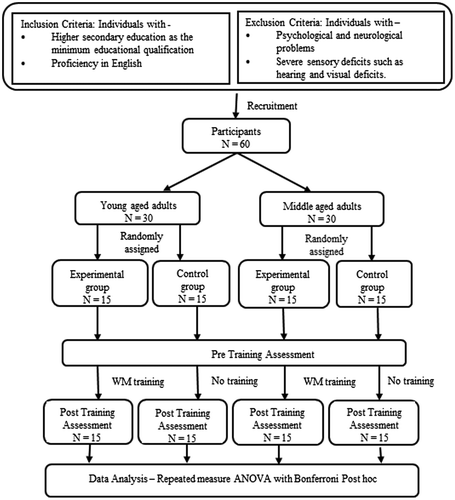Abstract
Objective: Cognitive training gains have been reported to be larger among young adults in comparison to older adults. However, differences in the magnitude of improvements between the earlier ages of adulthood have been less explored. In this attempt, the aim of the present study was to investigate the working memory training effects on cognitive communicative abilities among young- and middle-aged adults. Method: An interventional research design was incorporated. Thirty young- (19–40 years) and middle-aged (40–65 years) adults each, were recruited from the community and randomly assigned into the experimental and control groups. The experimental groups received 10 sessions of working memory training. Pre- and post-training assessments were performed and data was statistically analyzed. Results: The data analysis revealed no statistically significant difference in the training effects between young- and middle-aged adults, though young adults showed higher trends of improvement with training. Conclusion: The study highlights the importance of initiating working memory training at an early age to enhance or restore one’s cognitive abilities as age progresses.
Public Interest Statement
The global statistical data which is emerging with regard to the incidence of cognitive communication disorder like dementia is alarming. The increment in the incidence is expected to be multifold in South-East Asian countries like India. Therefore, various efforts are being made to either delay or decelerate the onset of the age-related pathological changes in cognition through early interventions. However, how early should an early intervention be, is unclear. The present study is an attempt to answer this by providing working memory training among healthy aging young- and middle-aged adults. It was found that the working memory training enhanced working memory and short-term memory abilities of both the participant groups. The gains were significantly higher for the young-aged adults, highlighting the need for promoting the sense of cognitive communicative well-being as early as in young adulthood.
1. Introduction
Cognition is a set of mental processes which aid in planning, initiating, shifting, and terminating certain bodily actions and behavior. These processes involve the use of inner representations to varying degrees and may function independently at different stages of processing. Neisser (Citation2014) defines cognition as “the mental process by which external or internal input is transformed, reduced, elaborated, stored, recovered, and used.” The effectiveness with which an individual communicates with others, reflects the ability of storage, manipulation, and execution of a task. The interaction of cognition and communication termed as cognitive communication includes various processes such as attention, memory, problem solving, reasoning, and executive function. Working memory is regarded as one of the most important cognitive communicative processes which involves simultaneous storage and manipulation of information (Baddeley & Hitch, Citation1974). It plays a major role in higher order cognition and action directed behaviors such as problem-solving and reasoning (Carpenter, Citation1994).
Working memory is reported to be sensitive to age (Hay & Jacoby, Citation1999). Cognitive decline occurs by as early as 30 years and accelerates beyond 45 years of age (Salthouse, Citation2009), suggesting the emergence of subtle declines in cognitive abilities during early middle age or even among young adults. Preventing or restoring working memory abilities with progression of age, becomes essential for an individual’s everyday functioning.
Working memory training has been proven to enhance and/or prevent cognitive decline during adulthood (Karbach & Verhaeghen, Citation2014). Most of the cognitive training studies have been performed on young (20–30 years) and old-aged (60–70 years) adults, with higher training gains reported among young-aged adults as compared to old-aged adults (Brehmer et al., Citation2008; Calero & Navarro, Citation2007; Verhaeghen, Marcoen, & Goossens, Citation1992). An aging brain demonstrates the presence of plasticity and the brain activity is subjected to change as it receives training. But due to the reduction in plasticity as age increases, these benefits become lesser in old-aged adults when compared to young-aged adults (Calero & Navarro, Citation2007). Old-aged adults also take a relatively longer time to relearn the strategies required to perform the tasks when compared to young-aged or middle-aged adults (Brehmer et al., Citation2008; Calero & Navarro, Citation2007). Conversely, there are also reports suggesting no difference in the magnitude of performance gains with working memory training among young (Mean age = 19.2 years) and old adults (Mean age = 69 years) (Bailey, Dunlosky, & Hertzog, Citation2014).
The World Health Organization estimate, as in 2015, reported 46.8 million people as having age linked cognitive communicative disorder, like dementia. These numbers are expected to double every 20 years and reach the magnitude of 74.7 million by 2030 and 131.5 million in 2050. In the world economies, like India, where the growth of the elderly population is rapidly taking place, a higher increase in the incidence of dementia is expected (Prince, Citation2015). The dementia report of India projected 3.7 million Indians as having dementia in 2010, with a total societal cost of 147 billion Indian Rupees. The report further predicted that these numbers might double by 2030, and costs would increase thrice (Shaji et al., Citation2010). This demands timely action to prevent or delay the onset of the disorder (Das, Pal, & Ghosal, Citation2012). Initiating working memory training at an early age becomes crucial in the prevention of cognitive communicative declines seen with age. Though training effects have been studied among young- and old-aged adults extensively, differences in training gains among young- and middle-aged adults have not been explored. Therefore, how early an intervention may prove to be beneficial remains unclear. In order to understand the stage of life when working memory training can best be instigated, it is essential to examine the differences in the magnitude of effects of training among the earlier ages of adulthood, i.e. the young and middle age. Addressing the national and global concerns along with the promotion of healthy cognitive-communicative well-being, the present research aims to investigate the effects of working memory training on cognitive communicative abilities among young- and middle-aged adults.
2. Methods
The present study followed an interventional research design and was approved by the Institutional Ethics Committee. An informed written consent was obtained from all the participants prior to their inclusion in the study.
2.1. Participants
A total of 30 young-aged adults (19–40 years) and 30 middle-aged adults (40–65 years) with senior secondary education as the minimum educational qualification, along with proficiency in English, were included in the study. The participants were recruited from the community, in and around Mangalore, Karnataka, India. Those who had any psychological or neurological problems, as ascertained by a cut-off score of <26 in Mini Mental State Examination (MMSE; Folstein, Folstein, & McHugh, Citation1975), and/or severe sensory deficits such as hearing and/or visual deficits were excluded from the study. The demographic details of the participants have been provided in Table . The participants of the experimental and control groups among young-aged adults and middle-aged adults were matched for age, gender, and years of education.
Table 1. Demographic details of participants
2.2. Procedure
The participants in both the age groups were randomly assigned into the experimental and control groups. The experimental groups received the working memory training for 10 sessions of 45 min duration each and the control groups did not receive the training and only attended the pre and post assessment sessions. The procedure of the study has been depicted in the flowchart as shown in Figure .
2.3. Working memory training
The working memory training for the present research was adopted from Namratha, George, Bajaj, Mridula, and Bhat (Citation2017). Training was provided on six working memory tasks, as described below.
Double Digit Ordering: This task involved series of double digits ranging from 3 to 6, presented in the auditory and visual modality simultaneously. Participants had to verbally recall the digits by arranging them in the ascending order.
Sentence ordering: In this task, sentences ranging from 3 to 6 words were presented in the auditory and visual modality simultaneously. Participants had to verbally recall the sentence by re-arranging the word order in increasing length.
Semantic Sorting: This task comprised of series of words, ranging from 3 to 7, from different categories, presented in the visual modality. Participants were instructed to recall the words by grouping them into their categories.
Multistage Problem-solving: This task involved problem statements ranging from 3 to 6, presented in visual modality. Participant had to solve the problems and derive at an accurate answer.
N-back: The N-back tasks consisted of faces, objects, words and letters. The levels of complexity ranged from 1-back to 3-back. Participants had to monitor the visually presented stimuli and respond to the stimuli that were same as the one presented “n” positions previously.
Verbal fluency: In this task, participants had to generate as many words as possible within one minute for simple and complex letters, simple and complex categories, with and without alternation and with an excluding letter.
The tasks were presented through the Paradigm software version 2.5.0.68. Prior to the initiation of training on each task, screening items from the tasks were presented to the participants to determine the complexity level at which training should begin for the participant. Training for each task began at one level below to the level failed in the screening. Sets of 10 stimuli were given to the participants to practice within the level of complexity the training began at. The training proceeded to the next level of complexity once the participant was able to correctly achieve 80% accuracy (8 out of 10) within the same level of complexity of a task. If 80% accuracy could not be obtained, the next set of ten stimuli was given for practice.
The training for all tasks except N-back and verbal fluency followed a similar paradigm. For the N-back tasks, the participants had to achieve 80% accuracy in matching the target and identifying the non-target stimuli to proceed to the higher complexity level. In the verbal fluency tasks, the number of words generated in a minute, were noted.
2.4. Pre- and post-training assessment
Pre-training assessment was done a session before the training commenced and the post training assessment were carried out within a day or two after the completion of the training. The assessment tasks included were computerized Short-term memory tasks (D’Souza, Bajaj, & Bhat, Citation2016)—face recall, name recall, object recall, first and second name association, face-name association, face-object association and Working memory tasks (Kumar, Bajaj, & Bhat, Citation2015)—digit ordering, letter ordering, digit-letter ordering, year ordering, and spell the word, as well as non-computerized Working memory tasks from Manipal Manual of Cognitive Linguistic Abilities (MMCLA; Mathew, Bhat, Sreya, & Arora, Citation2013)—auditory word recall, auditory wordlist recall, auditory delayed sentence recall, visual picture recall, visual wordlist recall, and visual delayed sentence recall. The description of the tasks have been given in Tables , and .
Table 2. Description of working memory tasks
Table 3. Description of short-term memory tasks
Table 4. Description of working memory tasks
3. Results
The data obtained were subjected to descriptive statistics and further data analysis was done using repeated measures ANOVA and Bonferroni post hoc test. A statistical package SPSS version 16.0 was used to do the analysis and significance level was set at 5%. The effects of working memory training on near transfer tasks and the trained tasks among young and middle-aged adults were assessed.
3.1. Effect of working memory training on near-transfer tasks among young- and middle-aged adults
The magnitude of training effects with respect to age on near transfer tasks of short-term memory were assessed by computing the difference between the mean differences (pre-post) of the experimental and control group in the young- and middle-aged groups as depicted in Figure .
Figure 2. Differences between mean differences of experimental and control group among young- and middle-aged adults for short-term memory tasks.

The differences in the pre–post measures among the experimental and control group of young-aged adults showed greater difference than the experimental and control group of middle-aged adults for all short-term memory tasks except face recall. These differences were found to be between group 1 vs. group 2 and group 3 vs. group 4, in which face recall task [F(1, 28) = 0.196, p = 0.002], name recall task [F(1, 28) = 0.989, p = 0.002], first second name association task [F(1, 28) = 6.182, p = 0.019], face name association task [F(1, 28) = 14.189, p = 0.001], face object association task [F(1, 28) = 8.258, p = 0.008] showed a statistically significant difference between the young experimental and control with the experimental group performing better than their corresponding controls. Similarly differences in the face recall task [F(1, 27) = 8.487, p = 0.007], name recall task [F(1, 27) = 6.067, p = 0.020], first second name association task [F(1, 27) = 4.865, p = 0.036], were observed to be statistically significant between the middle age experimental and control groups, with the experimental group performing better than their corresponding controls.
The magnitude of training effects with respect to age on near transfer working memory tasks were also assessed by computing the difference between the mean differences (pre-post) of the experimental and control group for the young- and middle-aged groups, as seen in Figures and .
Figure 3. Differences between mean differences of experimental and control group among young- and middle-aged adults for working memory tasks.
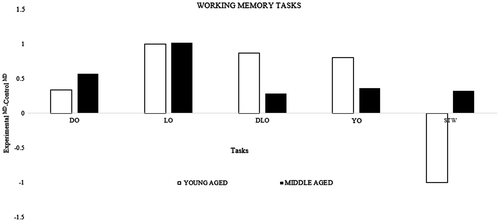
Figure 4. Differences between mean differences of experimental and control group among young and middle-aged adults for working memory tasks (MMCLA).
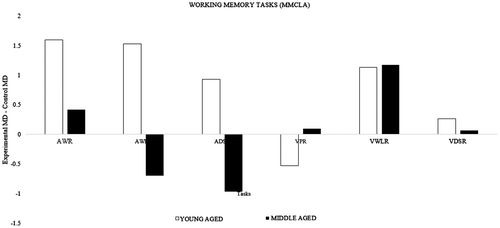
The differences in the pre-post measures among the experimental and control group of young-aged adults showed significantly greater differences for letter ordering, [F(1, 55) = 15.510, p = 0.000], digit letter ordering [F(1, 55) = 5.776, p = 0.020], year ordering [F(1, 55) = 5.107, p = 0.028], auditory word recall [F(1, 55) = 8.106, p = 0.006], visual word recall [F(1, 55) = 12.355, p = 0.001], than the differences in experimental and control group of middle-aged adults, except digit ordering, spell the word, auditory word list recall, auditory delayed sentence recall, visual picture recall, and visual delayed sentence recall. Significant differences were also found to be between group 1 vs. group 2 and group 3 vs. group 4, in which letter ordering [F(1, 28) = 12.023, p = 0.002], digit letter ordering [F(1, 28) = 7.258, p = 0.012], year ordering [F(1, 28) = 4.308, p = 0.047], auditory word recall [F(1, 28) = 8.862, p = 0.006], auditory word list recall [F(1, 28) = 12.553, p = 0.001], auditory delayed sentence recall [F(1, 28) = 4.953, p = 0.034], visual word list recall task [F(1, 28) = 10.166, p = 0.004] showed a statistically significant difference between the young experimental and control, with the experimental group performing better than their corresponding controls. The tasks, letter ordering [F(1, 27) = 5.673, p = 0.025], auditory delayed sentence recall [F(1, 27)=4.727, p = 0.039], visual word list recall [F(1, 27)=4.438, p = 0.045], showed a statically significant difference between the middle age experimental and control group with the experimental group performing better than their corresponding controls.
Though training effects are evident across the near transfer tasks among all the groups, no statistically significant age effects were observed, indicating similar magnitude of training gains between the young-aged and middle-aged adults.
3.2. Effect of working memory training on trained tasks among young- and middle-aged adults
The pre–post measures of the trained tasks between the young-aged and middle-aged experimental groups has been depicted in the Figures .
Figure 5. Average span for working memory training tasks depicting pre-post differences among young- and middle-aged adults.
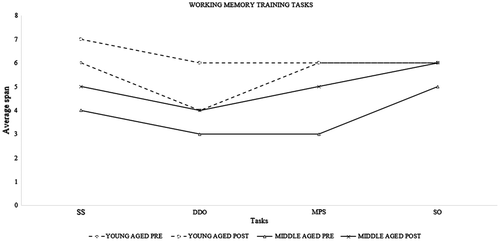
Figure 6a. Average span for working memory training tasks (N-back) depicting pre–post differences among young-aged adults.
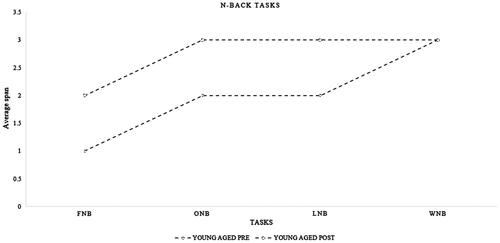
Figure 6b. Average span for working memory training tasks (N-back) depicting pre–post differences among middle-aged adults.
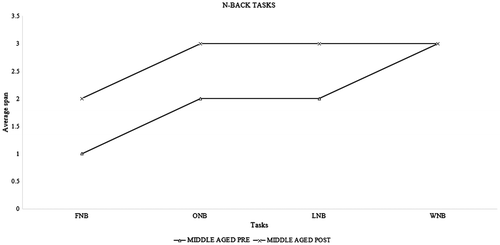
Figure 7a. Average score for working memory training tasks (verbal fluency) depicting pre–post differences among young- and middle-aged adults.
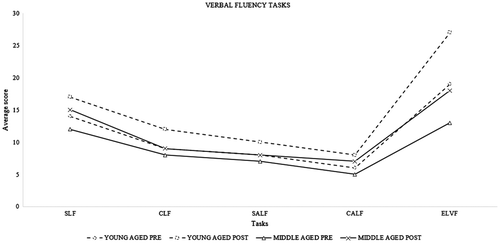
Figure 7b. Average score for working memory training tasks (verbal fluency) depicting pre–post differences among young- and middle-aged adults.
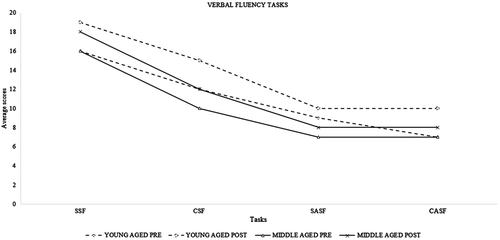
As observed in Figure , among the trained tasks young-aged adults showed greater gains (pre–post) in the working memory span for the semantic sorting task and double digit ordering task than the middle-aged adults however, middle-aged adults showed greater gains for multistage problem-solving and sentence ordering task than young-aged adults. Similarly for the N-back tasks as shown in Figures and , middle-aged adults showed greater gains for object N-back, Letter N-back and Word N-back tasks than the young-aged adults. There was an exception in the performance of Face N-back task, wherein, both the age groups performed equivalently. As observed from Figures and , young-aged adults showed greater gains (pre-post) in the verbal fluency task scores than the middle-aged adults.
Among the trained tasks, even though there was improvement in mean spans and scores of all the working memory tasks only multistage problem-solving [F(1, 27) = 10.387, p = 0.003], sentence ordering [F(1, 27) = 10.559, p = 0.003], object N-back [F(1, 27) = 5.147, p = 0.031], letter N-back [F(1, 27) = 10.016, p = 0.004] and word N-back [F(1, 27) = 14.162, p = 0.001], showed statistically significant difference between both the age groups, with middle-aged adults performing better than the young-aged adults. These findings could be due to the ceiling effects in these tasks for the young adults, who had limited scope for further improvement when compared to middle-aged adults.
Though training effects have been seen across all the groups and between the experimental and control of the young- and the middle-aged adults, no interaction between working memory training and age has been found, indicating that there was no difference between the training gains obtained for the young- and the middle-aged adults for the trained tasks.
4. Discussion
The present study evaluated the effect of working memory training among young- and middle-aged adults. For this purpose, working memory training was provided to young- and middle-aged adults and their performance was compared with their corresponding controls who did not receive any training. The pre and post assessments were conducted using near transfer tasks of short-term memory and working memory. The observation in the present study, sheds light on the effect of working memory training on the near transfer tasks and the trained tasks among young- and middle-aged adults.
4.1. Effect of working memory training on near transfer tasks among young- and middle-aged adults
The trends observed in the finding of the present study suggests that there were improvements in the near transfer tasks of short-term memory and working memory, among the experimental groups of young- and middle-aged individuals in comparison to their controls. These findings indicate that working memory training was effective in improving the working memory capacity as well as it had a transfer effect on short-term memory abilities too, in both the age groups. This is in line with the similar reports of improvement in the working memory tasks after working memory training among young adults (19–36 years) and old-aged adults (62–77 years) (von Bastian, Langer, Jäncke, & Oberauer, Citation2013). Researchers have also observed that the usage of strategies for training are well established and are generalized even to the near transfer tasks with training (von Bastian & Oberauer, Citation2013). A similar trend of training gains on the near transfer tasks on both young- (20–30 years) and old-aged adults (60–70 years) have been reported (Brehmer, Westerberg, & Bäckman, Citation2012). McAvinue et al. (Citation2013) showed that working memory training, using digit span task, sequencing task, verbal learning task, and N-back tasks showed its impact even on short-term memory on old-aged adults (64–79 years). The authors ascribe this to be the effect of the training tasks on the near transfer tasks as both the tasks share similar features. Working memory training effects have been reported even on far transfer tasks like fluid intelligence in middle-aged adults in the age range of 30 to 60 years (Lawlor-Savage & Goghari, Citation2016).
Working memory training has proven to have shown its transfer effects on several other cognitive communicative processes (Brehmer et al., Citation2012; Jaeggi, Buschkuehl, Jonides, & Shah, Citation2011). These transfer effects are also evident on the brain imaging studies, i.e. using functional magnetic resonance imaging, with changes observed in the fronto-parietal circuits and also changes in the neural networks (Nikolaidis, Voss, Lee, Vo, & Kramer, Citation2014). Neural plasticity in adults aids them in the effective usage of strategies in improving their performance (Miller, Citation1994). Thus, enhancement in the working memory abilities reflects the presence of neural plasticity (Klingberg, Citation2010). It has been observed that even at old age there is an overall change in the cellular metabolism after the working memory training (Chapman et al., Citation2015). The effects of working memory training have been reported to be present due to the increased integrity in the structures of the regions in the parietal lobe and corpus callosum which consists of white matter. These findings were well established in a study done by Takeuchi et al. (Citation2010) using the fractional anisotropy in which it was found that white matter integrity determines the plasticity of the working memory network. It was observed that, following working memory training there were changes in the neural plasticity which was important for the enhancement in the working memory performance, i.e. immediately after the working memory training there were changes in myelination of axons observed, leading to the changes in the white matter. Working memory training is also known to cause changes in the transfer of information from one hemisphere to another and this determines its role even in the executive function that involves working memory (Baddeley, Citation2003). There are profuse evidences which prove that the process of myelination occurs even during adulthood (Benes, Turtle, Khan, & Farol, Citation1994; Nunez, Citation2000) and with experiences and learning, myelination occurs with changes in the white matter structures (Koeste, Citation1985). Working memory training has shown to induce changes in the superior parietal lobe and the superior part of the right middle frontal gyrus. There are evidences that also show changes in the pattern of activation in the pre frontal cortex. There have also been increases in cerebral blood flow in the prefrontal cortex observed after working memory training (Mozolic, Hayaska, & Laurienti, Citation2010).
4.2. Effect of working memory training on trained tasks among young- and middle-aged adults
The results of the present study show that there were improvements in the trained tasks of working memory, among both the experimental groups of young- and middle-aged adults. However, among both the age groups, the young-aged adults showed larger gains in the working memory performance after the training, when compared to the middle-aged adults. But in few tasks like multistage problem-solving, sentence ordering, letter and word N-back, young-aged adults did not show much improvement as they did not have a scope to improve, due to the presence of ceiling effects. The middle-aged adults, however, showed training gains for all trained tasks and this could be because they had more scope for improvement, as their baseline performance was lower in comparison to that of the young-aged adults.
The improvements seen on the trained tasks in the young- and middle-aged experimental groups of the current study can also be attributed to the practice effects of the task (Engle, Tuholski, Laughlin, & Conway, Citation1999; Owen et al., Citation2010). During the course of the working memory training, participants could have developed individualized strategies to enable themselves in recalling and manipulating the stimuli better. In some tasks like semantic sorting, it was noted that individuals could perform better on related words than unrelated words. Tasks like double digit ordering, sentence ordering, letter and word N-back were performed relatively better than the other tasks which could be attributed to the combined auditory-visual modality of presentation. Working memory training with the presentation of both visual and auditory cues showed an increased ability in the storage, manipulation, and ready access of the items and this finding was associated in support with Baddeley’s working memory model that consists of an episodic buffer which helps in integrating the information that comes from both auditory (phonological loop) and visual modality (visuo-spatial sketchpad) (Delogu, Raffone, & Belardinelli, Citation2009). There are evidences which reveal improvements in the abilities of recognizing faces by middle-aged adults, after a cognitive intervention program which included face recall task for training and along with a distractor task, which was a general knowledge quiz in between the presentation of faces (Dolzycka, Herzmann, Sommer, & Wilhelm, Citation2014).
Both young- (20–30 years) and middle-aged (30–60 years) adults tend to rely on experiences to relate to the tasks, as compared to old-aged adults, who reach a point, where even if they relate to experiences, the beneficial outcome relatively takes a longer time than in young- and middle-aged adults (Denney, Citation1992). It is observed that, even though cognitive decline occurs in middle-aged adults, certain processes such as the semantic memory or autobiographical memory is relatively intact up to old age, which could be a possible reason for obtaining similar training gains among the young- and middle-aged adults. It has been stated that when old-aged adults attempted to perform equivalent to young-aged adults, there was a bilateral pattern of activation in the prefrontal cortex of the old-aged adults. But if the pattern of activation was mainly on the left prefrontal cortex like in young adults (20–35 years), then the performance of old-aged (64–74 years) adults was poorer than the young-aged adults (Cabeza, Anderson, Locantore, & McIntosh, Citation2002). Therefore, it can be hypothesized that young- and middle-aged adults have similar activation patterns of the prefrontal cortex, thus equalizing the training gains in both the age groups.
The current research has certain limitations. Firstly, the study limited itself to assessing only the near transfer effects of working memory training. Future research can be planned to examine the far transfer effects of working memory training also. Secondly, the study did not make an attempt to investigate the long-term training and maintenance effects on the cognitive abilities, making it difficult to comment on the temporal stability of the training gains between the two age groups.
5. Conclusion
The findings of the present study suggest both young- and middle-aged adults to have similar magnitude of gains in the working memory and short-term memory abilities following working memory training. Though the differences in the magnitude of training gains were statistically insignificant between the two age groups, the higher trends of change in the mean scores post training for trained tasks was observed among the young age group, which could probably suggest that young-aged adults possess a greater scope for improvement in their working memory capacity in comparison to the middle-aged adults. These findings can be applied towards the initiation of working memory training in young adulthood or latest by middle age, in order to facilitate early intervention of age related cognitive communication declines, thereby minimizing the burden this decline may pose on an individual’s everyday life. Timely intervention of this kind can prevent or decelerate the pathological cognitive communicative changes as seen in dementia, thus addressing the national and global concerns towards dementia.
Funding
This work was supported by the Technology Interventions for disabled and elderly, Department of Science & Technology, Government of India (DST-TIDE) [grant number SEED/TIDE/005/2013-[C]].
Additional information
Notes on contributors
J. Mridula
The cognitive communication research group at the Department of Audiology and Speech Language Pathology, Kasturba Medical College, Mangalore, Manipal University, Karnataka, India is involved in research activities relating to promote a sense of cognitive communicative well-being among the healthy aging adults. The research group, which is being financially supported by the Department of Science and Technology—Technology Intervention for the Disabled and Elderly, Government of India, is working towards a project for developing a cognitive-communicative self-learning tool for the healthy aging adults. The project involves objective and behavioral assessments of cognitive communication pre- and post-intervention. The present research is a section of the project addressing the behavioral changes in the working memory abilities, as a function of working memory intervention program, among the young- and middle-aged adults.
References
- Baddeley, A. (2003). Working memory and language: An overview. Journal of Communication Disorders, 36(3), 189–208.10.1016/S0021-9924(03)00019-4
- Baddeley, A. D., & Hitch, G. (1974). Working memory. Psychology of Learning and Motivation, 8, 47–89.10.1016/S0079-7421(08)60452-1
- Bailey, H. R., Dunlosky, J., & Hertzog, C. (2014). Does strategy training reduce age-related deficits in working memory? Gerontology, 60(4), 346–356.10.1159/000356699
- Benes, F. M., Turtle, M., Khan, Y., & Farol, P. (1994). Myelination of a key relay zone in the hippocampal formation occurs in the human brain during childhood, adolescence, and adulthood. Archives of General Psychiatry, 51(6), 477–484.10.1001/archpsyc.1994.03950060041004
- Brehmer, Y., Li, S. C., Straube, B., Stoll, G., von Oertzen, T., Müller, V., & Lindenberger, U. (2008). Comparing memory skill maintenance across the life span: Preservation in adults, increase in children. Psychology and Aging, 23(2), 227.10.1037/0882-7974.23.2.227
- Brehmer, Y., Westerberg, H., & Bäckman, L. (2012). Working-memory training in younger and older adults: Training gains, transfer, and maintenance. Training-induced Cognitive and Neural Plasticity, 72.
- Cabeza, R., Anderson, N. D., Locantore, J. K., & McIntosh, A. R. (2002). Aging gracefully: Compensatory brain activity in high-performing older adults. Neuroimage, 17(3), 1394–1402.10.1006/nimg.2002.1280
- Calero, M. D., & Navarro, E. (2007). Cognitive plasticity as a modulating variable on the effects of memory training in elderly persons. Archives of Clinical Neuropsychology, 22(1), 63–72.10.1016/j.acn.2006.06.020
- Carpenter, P. A. (1994). Working memory constraints in comprehension: Evidence from individual differences, aphasia, and aging. Handbook of Psycholinguistics, 1075–1122.
- Chapman, S. B., Aslan, S., Spence, J. S., Hart, J. J., Bartz, E. K., Didehbani, N., … Lu, H. (2015). Neural mechanisms of brain plasticity with complex cognitive training in healthy seniors. Cerebral Cortex, 25(2), 396–405.10.1093/cercor/bht234
- Das, S. K., Pal, S., & Ghosal, M. K. (2012). Dementia: Indian scenario. Neurology India, 60(6), 618.10.4103/0028-3886.105197
- Delogu, F., Raffone, A., & Belardinelli, M. O. (2009). Semantic encoding in working memory: Is there a (multi) modality effect? Memory, 17(6), 655–663.10.1080/09658210902998054
- Denney, N. W. (1992). Everyday problem solving: Methodological issues, research findings. Everyday Cognition in Adulthood and Late Life, 330.
- Dolzycka, D., Herzmann, G., Sommer, W., & Wilhelm, O. (2014). Can training enhance face cognition abilities in middle-aged adults? PLoS One, 9(3), e90249.10.1371/journal.pone.0090249
- D’Souza, D. F., Bajaj, G., & Bhat, J. S. (2016). Assessment of age related changes in self-efficacy and everyday short term memory (Unpublished dissertation). Manipal University.
- Engle, R. W., Tuholski, S. W., Laughlin, J. E., & Conway, A. R. (1999). Working memory, short-term memory, and general fluid intelligence: A latent-variable approach. Journal of Experimental Psychology: General, 128(3), 309.10.1037/0096-3445.128.3.309
- Folstein, M. F., Folstein, S. E., & McHugh, P. R. (1975). “Mini-mental state”: A practical method for grading the cognitive state of patients for the clinician. Journal of Psychiatric Research, 12(3), 189–198.10.1016/0022-3956(75)90026-6
- Hay, J. F., & Jacoby, L. L. (1999). Separating habit and recollection in young and older adults: Effects of elaborative processing and distinctiveness. Psychology and Aging, 14(1), 122.10.1037/0882-7974.14.1.122
- Jaeggi, S. M., Buschkuehl, M., Jonides, J., & Shah, P. (2011). Short-and long-term benefits of cognitive training. Proceedings of the National Academy of Sciences, 108(25), 10081–10086.10.1073/pnas.1103228108
- Karbach, J., & Verhaeghen, P. (2014). Making working memory work a meta-analysis of executive-control and working memory training in older adults. Psychological Science, 25(11), 2027–2037.10.1177/0956797614548725
- Klingberg, T. (2010). Training and plasticity of working memory. Trends in Cognitive Sciences, 14(7), 317–324.10.1016/j.tics.2010.05.002
- Koeste, J. (1985). Functional consequences of passive membrane properties of the neuron. In E. R. Kandell & J: H. Schwartz (Eds.), Principles of neural science (2nd ed., pp. 66–74) New York, NY: Elsevier.
- Kumar, N. P., Bajaj, G., & Bhat, J. S. (2015). Correlating conventional working memory tasks with variant everyday working memory tasks among young healthy adults. Paripex-Indian Journal of Research, 4(1), 120–122.
- Lawlor-Savage, L., & Goghari, V. M. (2016). Dual N-back working memory training in healthy adults: A randomized comparison to processing speed training. PLoS One, 11(4), e0151817.10.1371/journal.pone.0151817
- Mathew, M. M., Bhat, J. S., Sreya, N. M., & Arora, A. (2013). Manipal manual of cognitive linguistic abilities. Manipal University press.
- McAvinue, L. P., Golemme, M., Castorina, M., Tatti, E., Pigni, F. M., Salomone, S., … Robertson, I. H. (2013). An evaluation of a working memory training scheme in older adults. Frontiers in Aging Neuroscience, 5, 20.
- Miller, K. D. (1994). Models of activity-dependent neural development. Progress in Brain Research, 102, 303–318.10.1016/S0079-6123(08)60548-8
- Mozolic, J. L., Hayaska, S., & Laurienti, P. J. (2010). A cognitive training intervention increases resting cerebral blood flow in healthy older adults. Frontiers in Human Neuroscience, 4, 16.
- Namratha, H. G., George, V. M., Bajaj, G., Mridula, J., & Bhat, J. S. (2017). Effect of yoga and working memory training on cognitive communicative abilities among middle aged adults. Complementary Therapies in Clinical Practice, 28, 92–100.10.1016/j.ctcp.2017.05.007
- Neisser, U. (2014). Cognitive psychology: Classic edition. Psychology Press.
- Nikolaidis, A., Voss, M. W., Lee, H., Vo, L. K., & Kramer, A. F. (2014). Parietal plasticity after training with a complex video game is associated with individual differences in improvements in an untrained working memory task. Frontiers in Human Neuroscience, 8, 169.
- Nunez, P. L. (2000). Toward a quantitative description of large-scale neocortical dynamic function and EEG. Behavioral and Brain Sciences, 23(3), 371–398.10.1017/S0140525X00003253
- Owen, A. M., Hampshire, A., Grahn, J. A., Stenton, R., Dajani, S., Burns, A. S., … Ballard, C. G. (2010). Putting brain training to the test. Nature, 465(7299), 775–778.10.1038/nature09042
- Prince, M. J. (2015). World Alzheimer report 2015: The global impact of dementia: An analysis of prevalence, incidence, cost and trends. London: Alzhiemers Disease International.
- Salthouse, T. A. (2009). When does age-related cognitive decline begin? Neurobiology of Aging, 30(4), 507–514.10.1016/j.neurobiolaging.2008.09.023
- Shaji, K. S., Jotheeswaran, A. T., Girish, N., Bharath, S., Dias, A., Pattabiraman, M., & Varghese, M. (2010). Alzheimer’s and related disorders society of India. The dementia India report: Prevalence, impact, costs and services for dementia. New Delhi: ARDSI.
- Takeuchi, H., Sekiguchi, A., Taki, Y., Yokoyama, S., Yomogida, Y., Komuro, N., … Kawashima, R. (2010). Training of working memory impacts structural connectivity. Journal of Neuroscience, 30(9), 3297–3303.10.1523/JNEUROSCI.4611-09.2010
- Verhaeghen, P., Marcoen, A., & Goossens, L. (1992). Improving memory performance in the aged through mnemonic training: A meta-analytic study. Psychology and Aging, 7(2), 242–251.10.1037/0882-7974.7.2.242
- von Bastian, C. C., Langer, N., Jäncke, L., & Oberauer, K. (2013). Effects of working memory training in young and old adults. Memory & Cognition, 41(4), 611–624.10.3758/s13421-012-0280-7
- von Bastian, C. C., & Oberauer, K. (2013). Distinct transfer effects of training different facets of working memory capacity. Journal of Memory and Language, 69(1), 36–58.10.1016/j.jml.2013.02.002

